ALS Bundle
Can ALS Limited Maintain Its Momentum?
ALS Limited, a titan in testing, inspection, and certification (TIC) services, is charting a course for continued expansion. Its strategic acquisitions, such as the full ownership of Nuvisan, exemplify its dedication to growth, particularly in the life sciences sector. This exploration delves into the ALS SWOT Analysis, providing a comprehensive look at its strategic positioning.
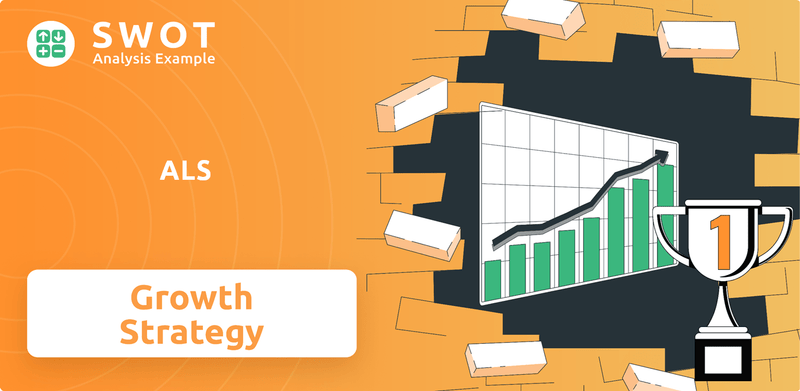
From its humble beginnings in the 1880s, ALS has evolved significantly, now offering comprehensive testing solutions across diverse industries. This evolution showcases a dynamic approach to market opportunities, with the company's future growth hinging on a multi-faceted strategy. This analysis will evaluate the ALS growth strategy, examining its ALS market analysis, and providing insights into its ALS company future prospects.
How Is ALS Expanding Its Reach?
The Brief History of ALS highlights the company's commitment to expansion, which is a key driver of its future prospects. ALS Limited is actively pursuing both organic and inorganic growth strategies to strengthen its market position and increase revenue streams. These initiatives are designed to capitalize on market opportunities and enhance shareholder value.
A significant portion of ALS's growth strategy involves strategic mergers and acquisitions (M&A). The company has a track record of successfully integrating acquired businesses, such as Nuvisan, Wessling, and York. These acquisitions are expected to contribute substantially to revenue growth. This approach allows ALS to quickly expand its service offerings and geographic reach.
To support these expansion efforts, ALS recently completed a fully underwritten $350 million placement. These funds are earmarked for organic investments in its laboratory network and to fund further growth and M&A initiatives. This financial backing demonstrates the company's commitment to its growth strategy and provides the resources needed to execute its plans effectively.
ALS has a history of successful M&A activity, integrating acquisitions like Nuvisan, Wessling, and York. These acquisitions are integral to the company's ALS growth strategy, contributing significantly to revenue expansion. The focus is on leveraging acquired capabilities to enhance service offerings and market reach.
The company is targeting mid-single-digit organic revenue growth for the Group in FY25. ALS is prioritizing growth in Environmental and Minerals businesses. The Life Sciences segment is expected to see improvements in operating margins, excluding recent acquisitions. These investments are crucial for long-term growth.
ALS's expansion plans are multifaceted, encompassing both organic and inorganic strategies. The company is focused on enhancing its service offerings and geographic reach to capitalize on market opportunities. This strategic approach aims to drive sustainable growth and increase shareholder value.
- M&A Integration: Successfully integrating recent acquisitions like Nuvisan, Wessling, and York to boost revenue.
- Organic Investments: Allocating funds to expand the laboratory network and support further growth initiatives.
- Segment Growth: Prioritizing growth in Environmental and Minerals businesses and improving Life Sciences margins.
- Capital Allocation: Deploying capital strategically to protect, extend, and expand the portfolio.
ALS SWOT Analysis
- Complete SWOT Breakdown
- Fully Customizable
- Editable in Excel & Word
- Professional Formatting
- Investor-Ready Format
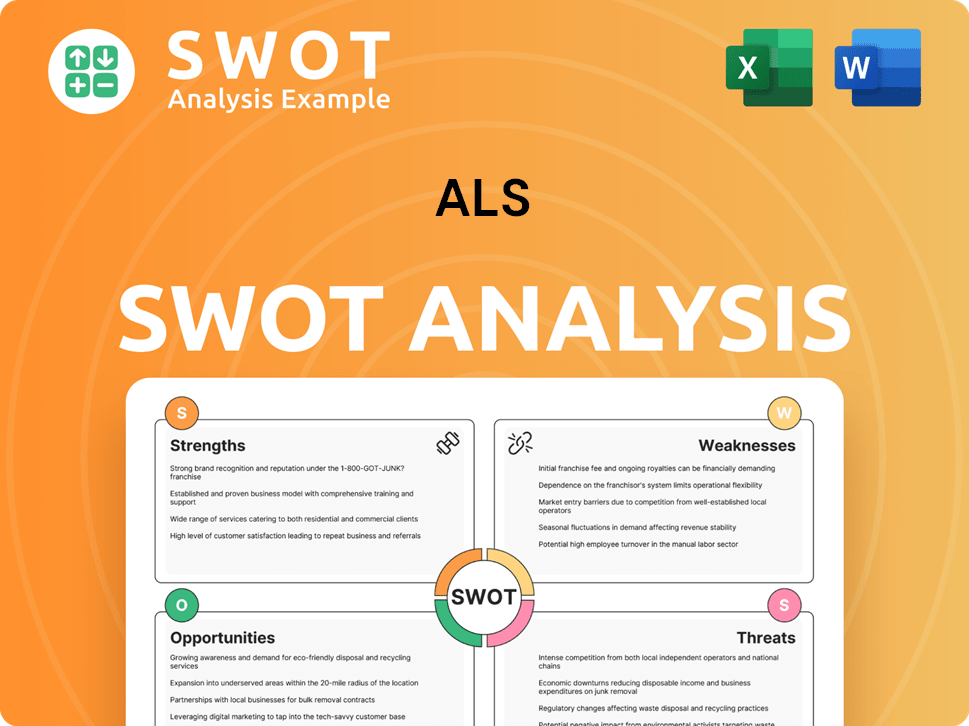
How Does ALS Invest in Innovation?
The innovation and technology strategy of the company is a key driver for its sustained growth, focusing on digital transformation and advanced analytical capabilities. This approach is crucial for enhancing service delivery, improving operational efficiency, and providing deeper insights for clients. The company's commitment to technological advancements is evident in its investments and strategic initiatives.
The company is actively investing in the advancement of global Laboratory Information Management Systems (LIMS). These systems provide consistent and unique data insights for clients. The development and expansion of AI and machine learning capabilities is a significant part of their strategy, achieved through both in-house efforts and strategic acquisitions. This data-driven approach is seen as a meaningful growth opportunity.
Furthermore, the company is focused on its digitalization agenda, making good progress on implementing a regionalized ERP approach and initiating the implementation of a global Human Resources Information System (HRIS). These initiatives are designed to boost operational efficiency and improve the employee experience, contributing to the company's overall growth objectives. These technological advancements are critical for the company's future.
The company is undergoing a digital transformation to improve its operational efficiency and service delivery. This includes implementing regionalized ERP systems and a global HRIS. These initiatives are designed to streamline processes and enhance data management.
Investing in advanced Laboratory Information Management Systems (LIMS) is a key focus. LIMS provide clients with consistent and unique data insights, which is crucial for informed decision-making. This investment supports the company's ALS market analysis and growth strategy.
The company is actively developing and expanding its AI and machine learning capabilities. This includes both internal development and strategic acquisitions to enhance its analytical capabilities. These technologies are essential for future growth and innovation.
The global Human Resources Information System (HRIS) is being implemented to improve operational efficiency and employee experience. The HRIS is projected to be deployed to approximately 30% of locations in the first half of FY26 and the remaining 70% in FY27. This phased approach ensures a smooth transition.
The company is assessing opportunities for AI and automation to drive further efficiencies within its business. This includes exploring various applications to streamline operations and reduce costs. This initiative supports the company's
The company's data-driven approach is a meaningful growth opportunity. By leveraging data analytics and insights, the company aims to enhance its service offerings and provide more value to its clients. This strategy is key to
The company's innovation strategy centers on leveraging technology to drive growth and efficiency. This includes investments in LIMS, AI, machine learning, and digital transformation initiatives like ERP and HRIS implementation. These advancements are crucial for maintaining a competitive edge and achieving long-term
- LIMS Upgrades: Continuous enhancements to LIMS to provide clients with better data insights.
- AI and ML Integration: Expanding AI and machine learning capabilities through both internal development and strategic acquisitions.
- HRIS Rollout: Phased implementation of a global HRIS to improve operational efficiency. The HRIS is projected to be deployed to approximately 30% of locations in the first half of FY26 and the remaining 70% in FY27.
- Automation Assessment: Evaluating opportunities for AI and automation to drive further efficiencies.
ALS PESTLE Analysis
- Covers All 6 PESTLE Categories
- No Research Needed – Save Hours of Work
- Built by Experts, Trusted by Consultants
- Instant Download, Ready to Use
- 100% Editable, Fully Customizable
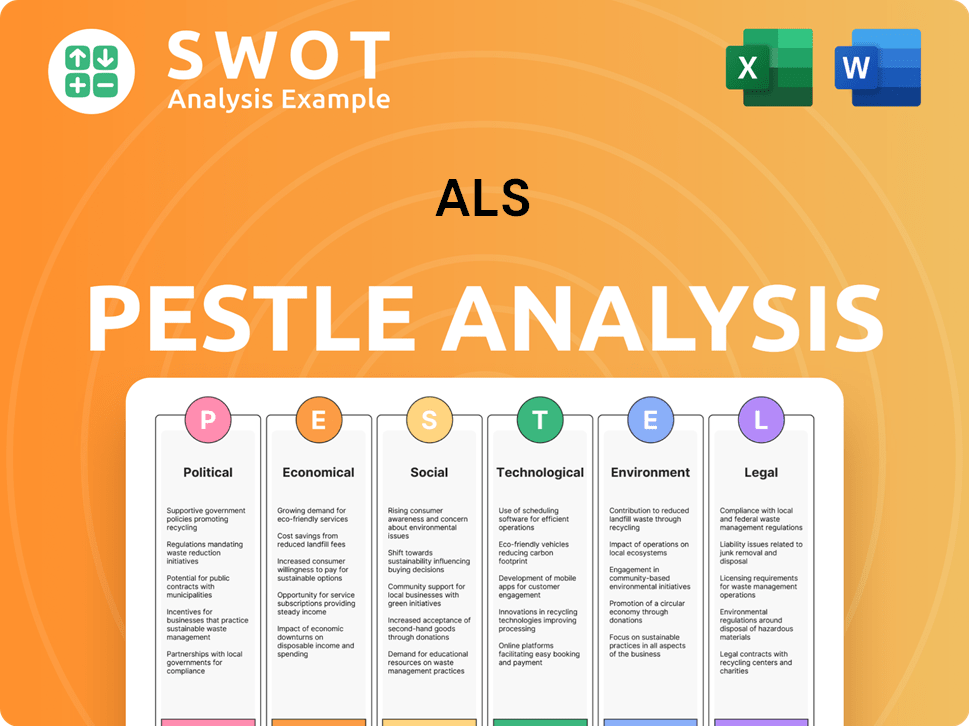
What Is ALS’s Growth Forecast?
The financial outlook for ALS Limited indicates a trajectory of sustained growth and robust performance across its diverse operational segments. The company's strategic initiatives and market positioning are designed to capitalize on emerging opportunities within the Life Sciences sector, while also navigating the dynamic conditions in the Commodities market. This approach is critical for the company's Mission, Vision & Core Values of ALS and long-term success.
In FY25, ALS reported underlying revenue of $3 billion, reflecting a 16.0% increase, primarily driven by strong organic and scope growth in Life Sciences. Despite facing softer conditions in Commodities, the company's diversified portfolio and strategic focus allowed it to maintain a strong revenue growth rate. This performance underscores the effectiveness of ALS's business development strategies and its ability to adapt to market fluctuations.
The company's underlying EBIT for FY25 increased by 4.7% to $515 million. The underlying operating margin, excluding recent acquisitions, improved to 19.1%. Statutory net profit after tax attributable to equity holders for FY25 was $256.2 million, a significant increase from $12.9 million in FY24, partly due to one-off impairment and restructuring provisions for Nuvisan in the previous year. These financial metrics highlight the company's operational efficiency and profitability.
ALS is targeting mid-single-digit organic revenue growth for the Group. Analyst forecasts project revenue to grow by 5.5% per annum on average over the next three years. This indicates a positive outlook for the ALS company future, driven by strategic initiatives and market expansion.
The company aims for a steady improvement in operating margins across its portfolio and strong ongoing cash generation. EBITDA cash conversion was 95% in FY25. This strong cash conversion rate reflects the company's efficient financial management and operational excellence.
ALS declared a final dividend of 19.7 cents per share for FY25, bringing the total dividends for the year to 38.6 cents per share. This represents a payout ratio of 60% of underlying NPAT, at the top end of their target range. The dividend reflects the company's commitment to returning value to shareholders.
Capital expenditure increased to $152 million in FY24, up from $146 million in the previous corresponding period, reflecting continued investment in growth. This investment supports the company's strategic planning and long-term growth potential.
The financial performance of ALS in FY25 demonstrates a strong foundation for future growth. The company's strategic focus on Life Sciences and operational efficiencies are key drivers of its success. The following points summarize the key financial achievements:
- Underlying revenue reached $3 billion, a 16.0% increase.
- Underlying EBIT increased by 4.7% to $515 million.
- Statutory net profit after tax attributable to equity holders was $256.2 million.
- EBITDA cash conversion was 95% in FY25.
- Final dividend of 19.7 cents per share, total dividends for the year 38.6 cents per share.
ALS Business Model Canvas
- Complete 9-Block Business Model Canvas
- Effortlessly Communicate Your Business Strategy
- Investor-Ready BMC Format
- 100% Editable and Customizable
- Clear and Structured Layout
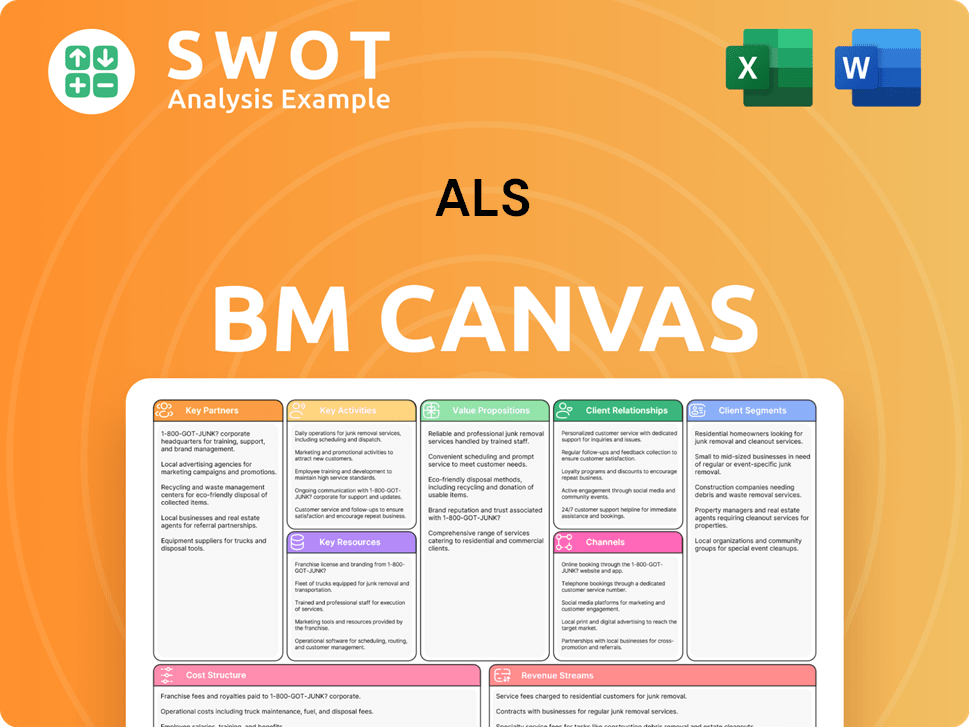
What Risks Could Slow ALS’s Growth?
The future of the company, and its ability to execute its ALS growth strategy, faces several potential risks and obstacles. These challenges range from market volatility to the complexities of mergers and acquisitions. Understanding these risks is crucial for assessing the company's long-term prospects and investment opportunities.
Market dynamics, particularly in the Commodities business, present a significant risk due to fluctuations in commodity prices and shifts in client demand. Successfully navigating these challenges requires proactive risk management and strategic planning. The company's approach involves diversification and robust operational strategies.
Growth-related activities, such as mergers, acquisitions, and market expansions, introduce their own set of risks. These include potential financial underperformance and integration difficulties. The company actively manages these risks through a structured Capital Allocation Framework and rigorous post-acquisition integration oversight.
Commodity price fluctuations and shifts in client demand pose risks to financial performance. The company's diversification across sectors and geographies helps mitigate these risks. The company's ability to adapt to evolving regulatory conditions is also crucial for long-term success.
Mergers, acquisitions, and market expansions can lead to financial underperformance and integration challenges. The updated Capital Allocation Framework and enhanced due diligence processes are key to managing these risks. Close oversight of post-acquisition integration is also essential.
Failure to successfully upgrade ERP systems or adopt digital solutions can impact operational efficiency and competitiveness. The Digital Application Roadmap and enhanced governance of digital initiatives are critical for mitigating these risks. Successfully navigating this transformation is key for the company's future.
Logistics constraints, geopolitical events, and supplier failures can disrupt the supply chain. Critical supplier redundancy planning and robust business continuity arrangements are essential for managing these risks. Maintaining a resilient supply chain is vital for operational stability.
Maintaining quality and data integrity is crucial for the company's reputation and operational success. Laboratory accreditations, quality control procedures, and proactive quality assurance programs help ensure these standards. This focus is vital for customer trust and regulatory compliance.
The company's comprehensive risk management framework, updated in March 2024, is designed to identify, analyze, evaluate, treat, monitor, and report on its portfolio of risks. This ensures that decisions align with the company's risk appetite. This framework is essential for long-term strategic planning and stability.
The company's digital transformation efforts, including ERP system upgrades, also present risks. Failure to adopt digital solutions could hinder operational efficiency and competitiveness. The Digital Application Roadmap and enhanced governance are critical for mitigating these risks.
Supply chain disruptions and maintaining quality and data integrity are also important considerations. The company addresses supply chain issues through critical supplier redundancy planning and business continuity arrangements. Laboratory accreditations and quality control procedures are used to maintain high standards.
ALS Porter's Five Forces Analysis
- Covers All 5 Competitive Forces in Detail
- Structured for Consultants, Students, and Founders
- 100% Editable in Microsoft Word & Excel
- Instant Digital Download – Use Immediately
- Compatible with Mac & PC – Fully Unlocked
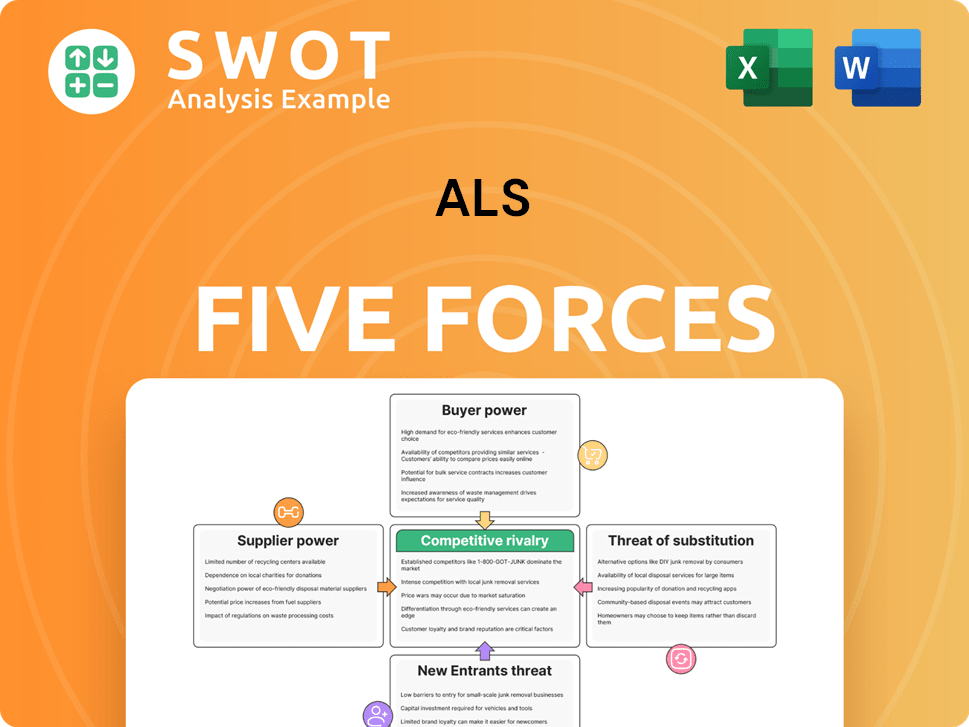
Related Blogs
Disclaimer
All information, articles, and product details provided on this website are for general informational and educational purposes only. We do not claim any ownership over, nor do we intend to infringe upon, any trademarks, copyrights, logos, brand names, or other intellectual property mentioned or depicted on this site. Such intellectual property remains the property of its respective owners, and any references here are made solely for identification or informational purposes, without implying any affiliation, endorsement, or partnership.
We make no representations or warranties, express or implied, regarding the accuracy, completeness, or suitability of any content or products presented. Nothing on this website should be construed as legal, tax, investment, financial, medical, or other professional advice. In addition, no part of this site—including articles or product references—constitutes a solicitation, recommendation, endorsement, advertisement, or offer to buy or sell any securities, franchises, or other financial instruments, particularly in jurisdictions where such activity would be unlawful.
All content is of a general nature and may not address the specific circumstances of any individual or entity. It is not a substitute for professional advice or services. Any actions you take based on the information provided here are strictly at your own risk. You accept full responsibility for any decisions or outcomes arising from your use of this website and agree to release us from any liability in connection with your use of, or reliance upon, the content or products found herein.